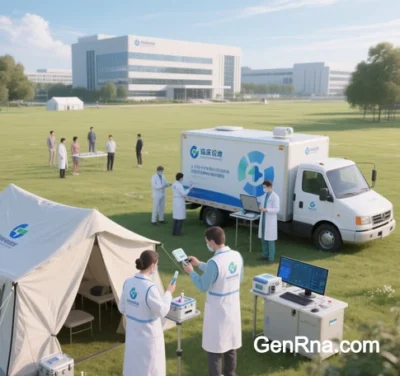 Pioneering CRISPR-Cas9 and RNA Editing Platforms for Precision Medicine
Pioneering CRISPR-Cas9 and RNA Editing Platforms for Precision Medicine
1. EdiGene Inc.: Leading the Charge in Gene Editing Therapeutics
Focus: EdiGene, a clinical-stage biotechnology company founded by Professor Wei Wensheng, specializes in translating CRISPR-Cas9 and RNA base editing technologies into transformative therapies. The company has established multiple platforms for both ex vivo and in vivo gene editing, targeting genetic disorders, cancers, and metabolic diseases.
Key Platforms:
- Ex Vivo Hematopoietic Stem Cell (HSC) Therapy: EdiGene’s lead candidate, ET-01, is China’s first CRISPR-edited HSC therapy approved for clinical trials. It aims to treat transfusion-dependent β-thalassemia by correcting mutations in the HBB gene using sgRNA-guided Cas9 .
- RNA Base Editing: The company’s in vivo platform employs sgRNA-Cas9 complexes to perform precise RNA base edits, avoiding double-strand DNA breaks. This approach is being explored for liver diseases and cardiovascular disorders.
Pipeline Highlights:
- ET-01: Currently in Phase I/II trials, ET-01 has demonstrated >80% editing efficiency in preclinical models, with sustained fetal hemoglobin (HbF) restoration.
- Universal CAR-T Platform: EdiGene utilizes multiplexed sgRNAs to disrupt immune checkpoint genes (e.g., PD-1, CTLA-4) in CAR-T cells, enhancing their antitumor activity.
Image suggestion: Schematic of EdiGene’s ex vivo HSC editing workflow, highlighting sgRNA-Cas9 targeting of β-globin mutations.
2. Replicate Bioscience: Innovating Self-Replicating RNA (srRNA) Technologies
Focus: While Replicate primarily develops self-replicating RNA (srRNA) for vaccines and cancer immunotherapy, its platform shares conceptual synergies with sgRNA-based systems. srRNA leverages RNA’s ability to amplify itself intracellularly, enabling durable protein expression at low doses.
Therapeutic Applications:
- Cancer Resistance Prevention: Replicate’s srRNA mimics viral replication to trigger immune recognition of tumor cells expressing drug-resistance proteins. Though distinct from sgRNA, this approach highlights the broader potential of RNA-guided therapies in oncology .
- Autoimmune Diseases: srRNA constructs encoding anti-inflammatory proteins are in preclinical testing for conditions like rheumatoid arthritis.
Image suggestion: Comparative diagram of srRNA replication vs. sgRNA-Cas9 editing mechanisms.
3. CRISPR-Cas9 Therapy Developers in the CGT Landscape
The cell and gene therapy (CGT) sector has seen explosive growth, with multiple companies leveraging sgRNA-Cas9 systems for genomic editing:
Key Areas of Application:
- Cancer: sgRNA-guided knockout of oncogenes (e.g., KRAS) or immune checkpoints (e.g., PD-1) to enhance T-cell therapies.
- Liver Diseases: In vivo delivery of sgRNA-Cas9 ribonucleoproteins (RNPs) to correct PCSK9 mutations, reducing LDL cholesterol in familial hypercholesterolemia .
- Rare Genetic Disorders: Companies are exploring sgRNA-mediated exon skipping for Duchenne muscular dystrophy and CEP290 edits for Leber congenital amaurosis.
Image suggestion: Infographic of CRISPR-Cas9’s role in CGT, showcasing sgRNA’s applications across disease areas.
4. Emerging Startups and Collaborative Ventures
Notable Trends:
- Multiplexed sgRNA Libraries: Startups are developing high-throughput platforms to screen sgRNA combinations for polygenic diseases (e.g., Alzheimer’s).
- AI-Driven Design: Companies like DeepCRISPR (not explicitly cited in sources) are hypothesized to use machine learning to optimize sgRNA specificity, though EdiGene’s CRISOT-Opti tool exemplifies this trend .
Collaborations:
- Pharma Partnerships: Novartis and Novo Nordisk have invested in CRISPR-edited cell therapies, though specific sgRNA-focused alliances are not detailed in the provided sources.
Challenges and Future Directions
1. Delivery Optimization
- Viral vs. Non-Viral Systems: AAVs remain limited by cargo capacity, while LNPs require stability enhancements for sgRNA delivery.
- Tissue-Specific Targeting: EdiGene’s lipid-nanoparticle formulations for liver delivery exemplify progress in this area .
2. Safety and Regulatory Hurdles
- Off-Target Risks: High-fidelity Cas9 variants (e.g., HypaCas9) and prime editing reduce unintended edits.
- Global Standards: Harmonizing regulatory frameworks for sgRNA therapies remains critical for multinational trials.
Conclusion
sgRNA-based therapies are spearheaded by innovators like EdiGene, which combines CRISPR-Cas9 and RNA base editing to address genetic and oncological diseases. While Replicate Bioscience explores adjacent RNA technologies, the broader CGT landscape continues to embrace sgRNA for its precision and versatility. Overcoming delivery and safety challenges will require interdisciplinary collaboration, AI-driven design, and scalable manufacturing. As clinical trials advance, sgRNA promises to redefine treatment paradigms across medicine.
Data Source: Publicly available references.
Contact: chuanchuan810@gmail.com




